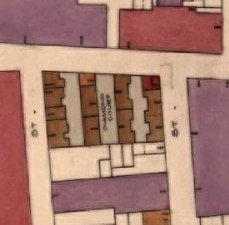|
Herbert Brown Ames, "The City Below the Hill" (1897)
In 1895, Ames purchased land upon the south-east side of William street (between Ann and Shannon Streets) in the heart of Griffintown. Upon this land, Ames built "four blocks of buildings, containing homes of varying size and rental, for 39 families, with a grocery store upon the corner where no liquor is sold." (Ames, 112-3) This model housing complex was called Diamond Court and was designed to provide safe and sanitary living conditions combined with spaces providing privacy and areas to be used in common. Families in the same complex would share a single front door, gas-lit vestibule, and inside stairways to their respective apartments. Other innovations included solid brick construction, concrete kitchen floors with central drains, a furnished stove, sink, washtub and water closet. A janitor, whose services were given in lieu of rent, also resided on the premises. - Industrial Architecture of Montreal
Almost a century later, Ames' experiment in social housing would succumb to some of the same forces which Ames himself fought against at the end of the nineteenth century. Ironically, this limited-dividend model of social housing was eventually torn down in the 1970s as 'slum housing.' - Industrial Architecture of Montreal
Ames exhorte les hommes d'affaires à construire des logements ouvriers répondant à certaines normes de qualité, d'espace et d'aération qui rapporteront tout de même un certain profit à leurs propriétaires; c'est ce qu'il appelle la philanthropie à 5%. Mais son message ne sera pas entendu. Ames reste le seul homme d'affaires à appliquer la philanthropie à 5% en faisant construire un ensemble de quatre maisons, appelé Diamond Court, pouvant loger 39 familles au coeur de la "ville en bas de la colline", rue William, entre les rues Ann et Shannon (cet ensemble résidentiel n'existe plus aujourd'hui). - Centre d'histoire de Montréal
|






